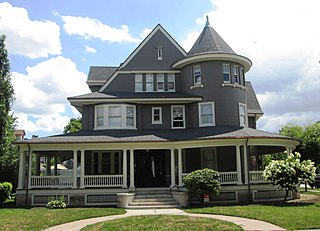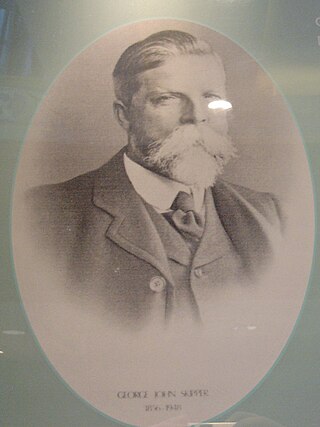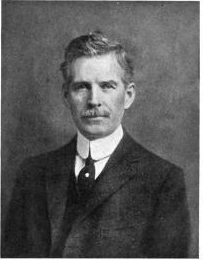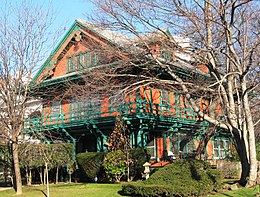
Prospect Park South is a small neighborhood in Flatbush, Brooklyn, New York City, located south of Prospect Park. It is included within the Prospect Park South Historic District, which was designated by the New York City Landmarks Preservation Commission in 1979 and listed on the National Register of Historic Places in 1983. The historic district is bounded by Church Avenue to the north, the BMT Brighton Line of the New York City Subway to the east, Beverley Road to the south, and between Stratford Road and Coney Island Avenue to the west.

Peabody & Stearns was a premier architectural firm in the Eastern United States in the late 19th century and early 20th century. Based in Boston, Massachusetts, the firm consisted of Robert Swain Peabody (1845–1917) and John Goddard Stearns Jr. (1843–1917). The firm worked on in a variety of designs but is closely associated with shingle style.

Carrère and Hastings, the firm of John Merven Carrère and Thomas Hastings, was one of the outstanding American Beaux-Arts architecture firms. Located in New York City, the firm practiced from 1885 until 1929, although Carrère died in an automobile accident in 1911.

Willis Jefferson Polk was an American architect, best known for his work in San Francisco, California. For ten years, he was the West Coast representative of D.H. Burnham & Company. In 1915, Polk oversaw the architectural committee for the Panama–Pacific International Exposition (PPIE).
Albert Lincoln Farr was an American residential architect, who designed homes in the Craftsman and Georgian styles.

Bradshaw Gass & Hope is an English architectural practice founded in 1862 by Jonas James Bradshaw. It is Bolton's oldest architectural practice and has exhibited archive drawings in London and Manchester. The style "Bradshaw Gass & Hope" was adopted after Bradshaw’s death to incorporate the names of the remaining partners, John Bradshaw Gass and Arthur John Hope. As of 2022, the firm continues to operate from offices in Bolton.

Charles Henry Owsley (1846–1935) was an English-born American architect in practice in Youngstown, Ohio, from 1872 until 1912.

George John Skipper (1856–1948) was a leading Norwich-based architect of the late Victorian and Edwardian period. Writer and poet, John Betjeman said of him "he is altogether remarkable and original. He was to Norwich what Gaudi was to Barcelona" He is regarded as an important Modern Style architect.

The Architecture of Buffalo, New York, particularly the buildings constructed between the American Civil War and the Great Depression, is said to have created a new, distinctly American form of architecture and to have influenced design throughout the world.

Leoni W. Robinson (1851-1923) was a leading architect in New Haven, Connecticut.

Raymond F. Almirall (1869–1939) was an American architect of the Beaux-Arts period, practicing in New York City.

Albert Randolph Ross was an American architect, known primarily for designing libraries, especially those funded by Andrew Carnegie. His father, John W. Ross, was an architect based in Davenport, Iowa, and the architect of its city hall.
William Robinson Miller (1866–1929) was an American architect from Maine. He specialized in richly ornamented Romanesque- and French-Revival buildings. Born in Durham, Maine, Miller attended Bates College and the School of Architecture at the Massachusetts Institute of Technology (1891–1892).

Austin Willard Lord FAIA was an American architect and painter. He was a partner in the firm of Lord & Hewlett, best known for their work on the design of the former William A. Clark House on Fifth Avenue in New York.

Wilfred Elizur Griggs (1866–1918) was an American architect from Waterbury, Connecticut.

The architecture of Jacksonville is a combination of historic and modern styles reflecting the city's early position as a regional center of business. According to the National Trust for Historic Preservation, there are more buildings built before 1967 in Jacksonville than any other city in Florida, though few structures in the city center predate the Great Fire of 1901. Numerous buildings in the city have held state height records, dating as far back as 1902, and last holding a record in 1981.

Archibald I. Lawrence (1869–1950), usually referred to as A. I. Lawrence, was an American architect who practiced in Berlin, New Hampshire, and Burlington, Vermont.

Davis & Brooks was an American architectural firm based in Hartford, Connecticut, active from 1897 to 1919. It was established by F. Irvin Davis (1869-1944) and William F. Brooks (1872-1950). Among their projects is the Hartford Municipal Building, completed in 1915.
George Carnegie Palmer, was an American architect who specialized in designing Beaux Arts style civic and academic buildings in the United States. He is best known for his work with the architect Henry F. Hornbostel. By 1904, Palmer & Hornbostel ranked "among the leading architects in the United States."



















